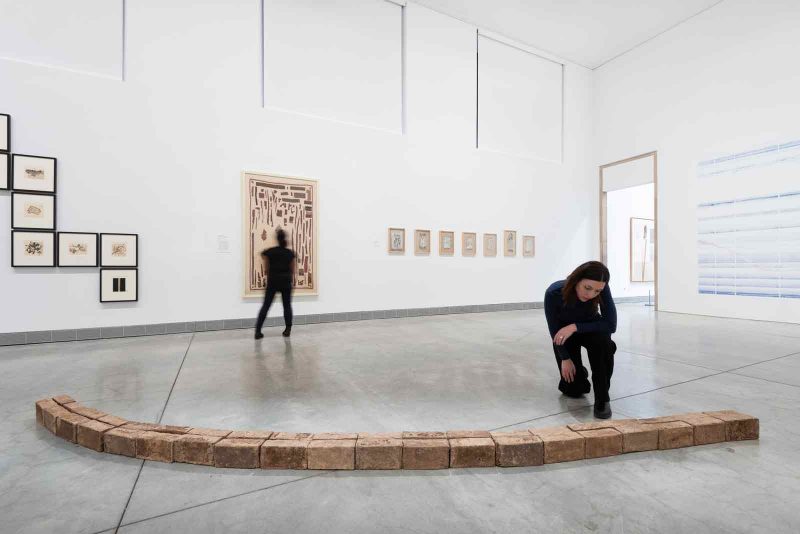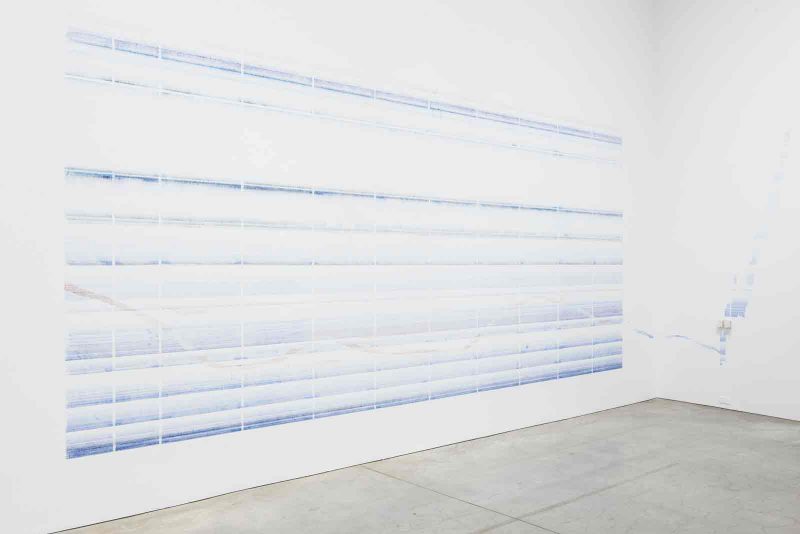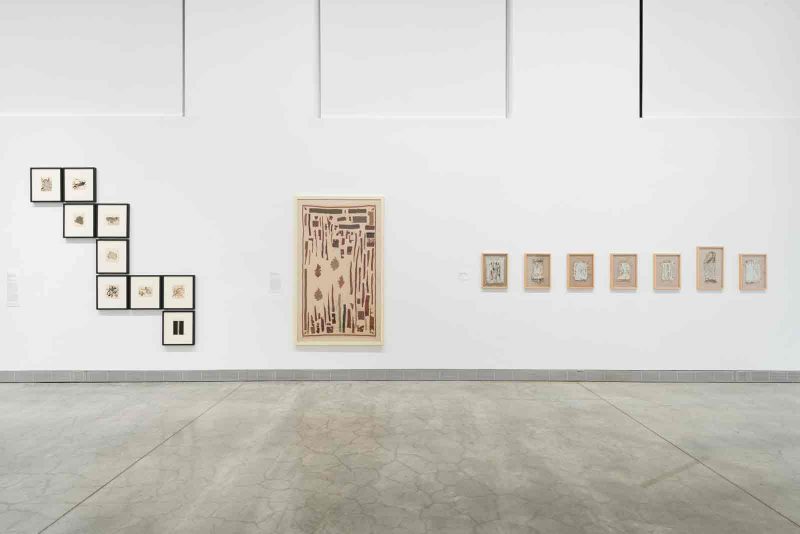
Fault Lines: Contemporary Abstraction by Artists from South Asia, on view at the Philadelphia Museum of Art (PMA) through Oct. 10, is a beautiful exhibition of work that will be unfamiliar to many viewers; it was sensitively curated by Amanda Sroka and features the work of six, South Asian artists from two generations. The two senior artists have received some attention in the U.S.. Zarina (Zarina Hashmi, 1937-2020, who painted under the single name), lived on several continents but spent the longest amount of time in New York City. Her work was shown in a solo exhibition at the Guggenheim Museum in New York in 2013. Nasreen Mohamedi (1937-1990), who was a pioneering figure in Indian abstraction, had a solo exhibition at the Met Breuer in 2016.
Fault Lines is an exhibition that lends itself to slow viewing; a quick run through the gallery is unlikely to be rewarding or even very memorable. The exhibit demonstrates personal and individual uses of abstraction, often put to representational uses, and most of the pieces are rooted in specific locales. We are reminded that maps and scientific charts present the physical world as abstractions, and that the geometric nature of much architecture and urban planning is always a response to the people who will use the spaces. The artworks also reveal the surprisingly-sensual possibilities of monochrome; all of the works employ extremely reduced palettes, often limited to black and white.
On entering the gallery, the first work to the left of the introductory text is Zarina’s Hanging in There (2000), which wraps around the corner opposite the entrance at slightly above eye level. A large array of simple, but not uniform, tweezer-like forms sit close to each other, attached by loops to a taught, horizontal line. It is a drawing made of wire that plays with its own shadows and evokes multiple possible referents: birds sitting on an electrical wire, people waiting in line, or at a different scale, barbed wire. Its formal elegance and openness to interpretation are characteristic of the artist, who is better known for her work on and with paper.
Along the back wall a portfolio of Zarina’s woodcuts from 2003 displays a range of forms and patterning that are schematic maps of cities whose land has been contested, often by war, including Sarajevo, Beirut, Ahmedabad, Kabul and Baghdad. The urban plans are alternately regular and random, geometric and biomorphic, created with scratchy patterns or with clear forms. Her representation of New York City takes the form of a Barnett Newman zip painting – a severe reduction of the regularity of Manhattan’s streets. These geometricized plans imply a control over the natural landscape that is undermined by humankind’s endless violence and struggles for power. The artist’s family was forced to leave India during Partition, so violence and exile were foundational to her experience.
The three ink drawings by Nasreen Mohamedi from 1985 resemble axiometric, architectural drawings, and the artist used a drafting table for her work. Her delicate and highly-detailed drawing style implies space without ever resolving into fixed forms, which is perhaps why they they have a utopian quality to them.
Works by the four younger artists employ media as more than means to convey form but are also an inherent part of their subject matter; they often make reference to the location of their sources and their uses within traditional culture. The series of sixteen square paintings by Prabhavathi Meppayil (b. 1965) reveal faint, horizontal lines that appear and disappear within their white grounds; they are constructed of copper wire set in gesso, materials the artist was familiar with from her family’s background as goldsmiths. The detailed and often repetitive handwork acknowledges the significance of vernacular traditions and their possibilities as a visual language for contemporary art.

On the far wall Tanya Goel’s (b. 1985) huge drawing wraps around a corner of of the gallery. “Index V” (2015/20) takes its form from global changes in the recorded sea level over centuries. It was created with snap lines, as used by builders and surveyors, and pigments made from local bricks and neem (indigo) – both materials are fundamental to Indian culture and tied to the location of their sources. The interest in sea levels reflects the crucial significance of rainfall to a climate with huge swings from monsoons to draught. Her painting “notation in x,y,z” (2015) is a remarkably beautiful grid whose colors derive from debris sourced at locations across New Delhi which the artist ground into pigments of subtly differing textures. Goel converts a foundational modernist form into a poetically sensual record of mundane and overlooked material that is the by-product of the city’s growth.
A large, loopy wall hanging by Priya Ravish Mehra (b. 1961) is constructed of fabric and needles bound with thread into a rope-like form which the artist used to create something like a three-dimensional drawing on the wall that spills onto the floor. Mehra was trained as a weaver and the materials she used are employed in a darning or mending process, “rafoogari,” a centuries-old but dying skill practiced in Najibabad. Highly-skilled needle workers mend valuable Kashmiri shawls so they appear unblemished; the process spiritually transcends the shame of wearing patched clothing. The artist saw her “rafoogari” as a metaphoric act of social mending as well as an acknowledgment of a craft tradition that has been unacknowledged because it was intended to be invisible.
Sheela Gowda (b. 1957) constructed “A Blanket in the Sky” (2004) from local materials which are closely associated with both religious and secular uses. It appears to be a minimalist tower of weathered metal, of the sort which the poor scavenge to create housing. But its apertures on two, adjacent sides reveal different associations; one houses a worn blanket, presumably left by someone who was sleeping rough, while the second reveals a cityscape under a sky filled with stars.
After independence, artists in India, and later in Pakistan, faced the challenge common to all post-colonial states: how to forge a national culture that both spoke to the new state and represented that state within an international community. One group of artists working in Bengal decided to draw on the great traditions of Indian painting and sculpture that survived mostly in religious sites, as well as the extensive craft traditions of vernacular culture. Another group working in Bombay thought a modern Indian art should be consistent with international modernism, which at the time favored abstraction. The artists here work in the same formats and visual language as their international peers but have found ways to create art that is tied to its origins in the sub-continent. Abstraction risks becoming untethered from its context and hence seen in purely Western, formal terms. I am grateful that the Philadelphia Museum of Art has provided the background necessary to expand our understanding of contemporary art.
“Fault Lines: Contemporary Abstraction by Artists from South Asia,” Alter Gallery 276,
Main Building, Philadelphia Museum of Art (PMA). On view through October 10, 2021.










